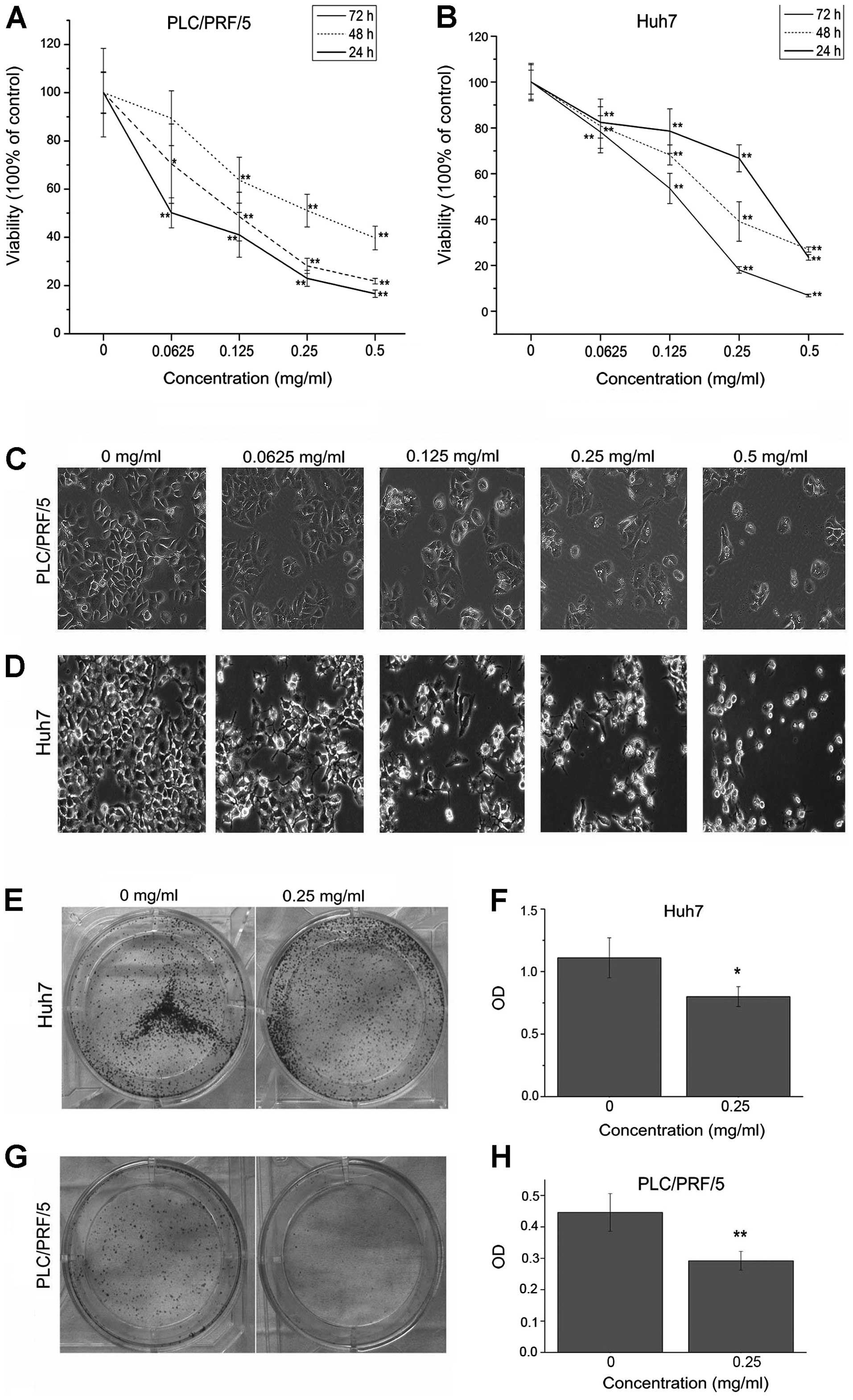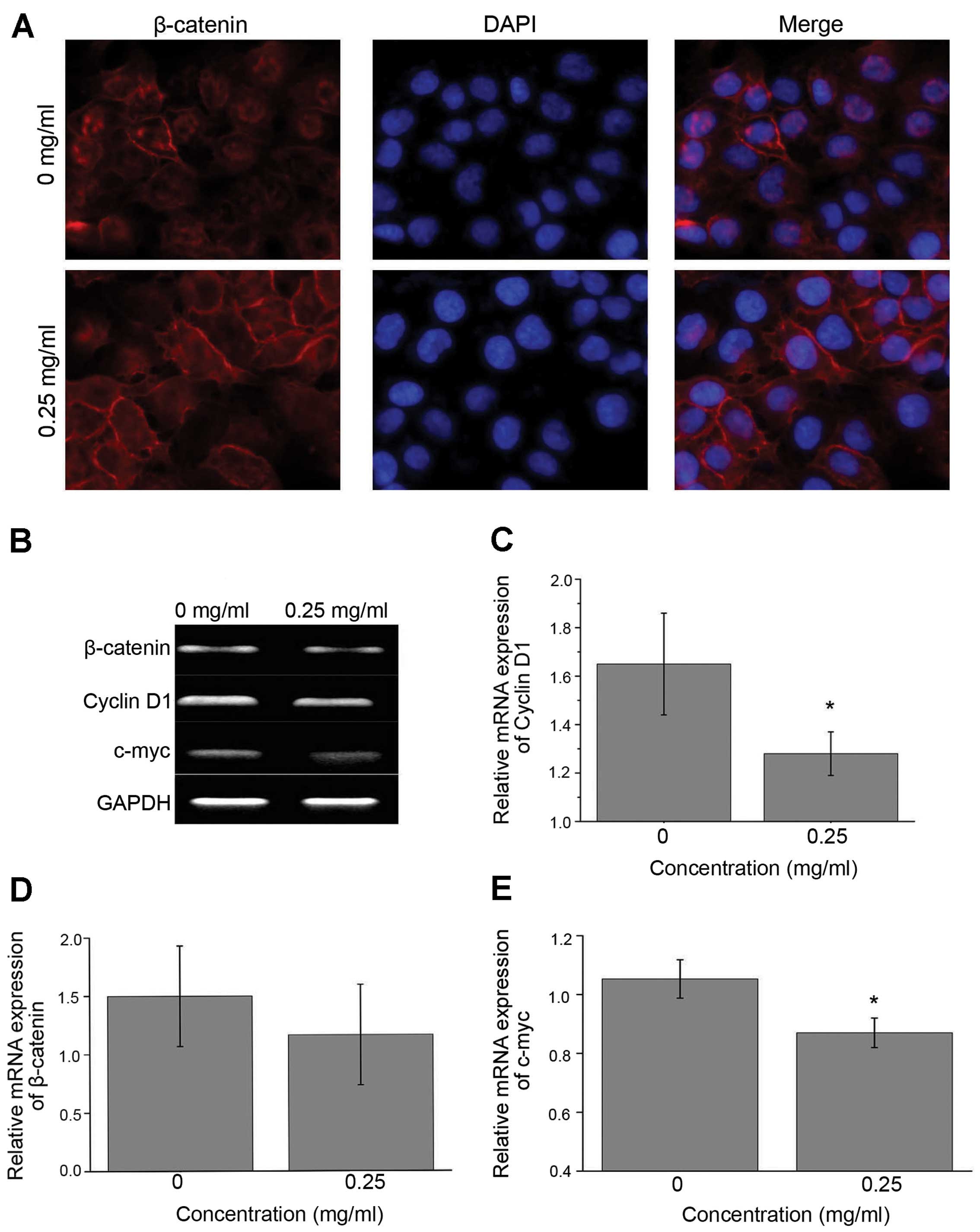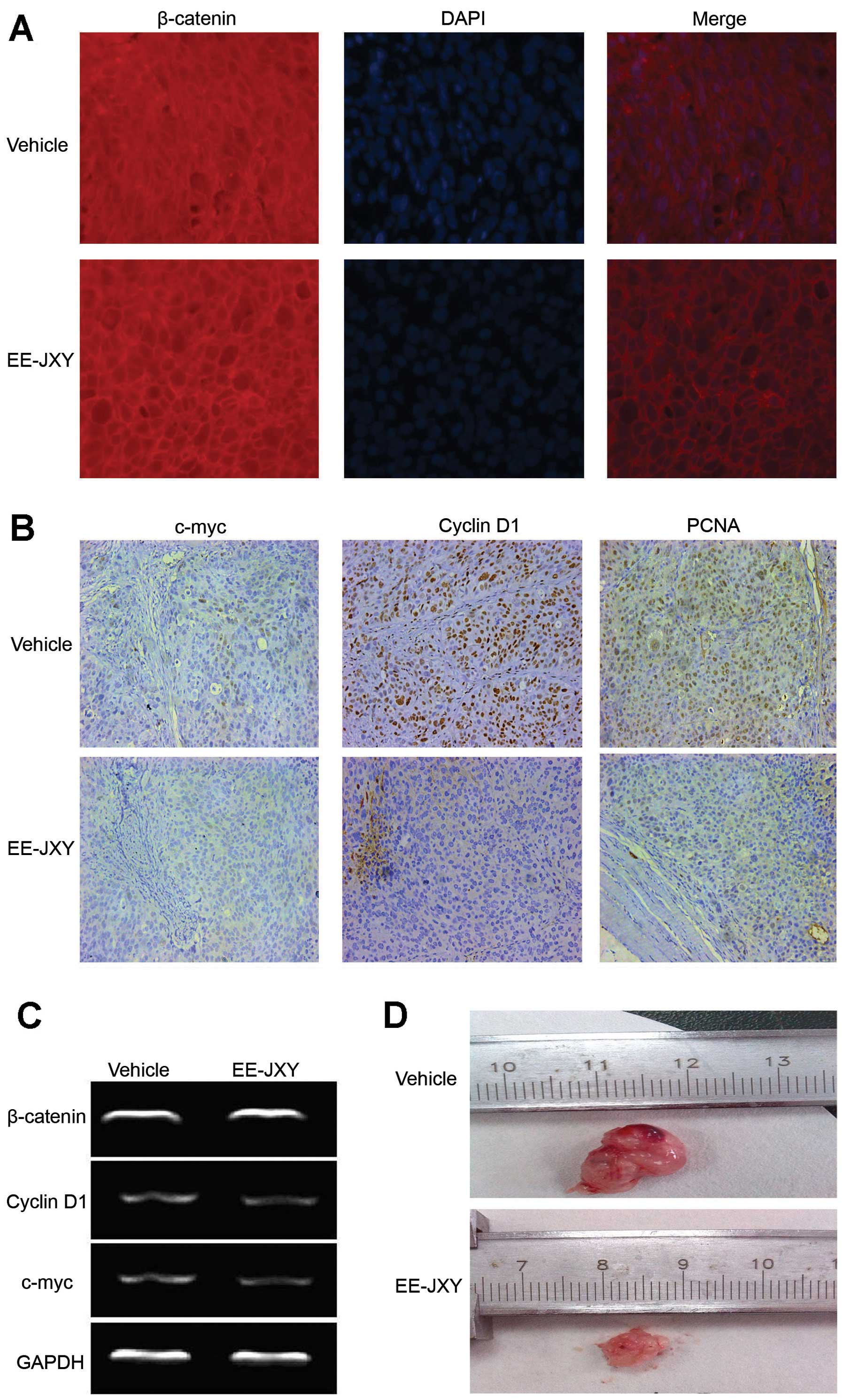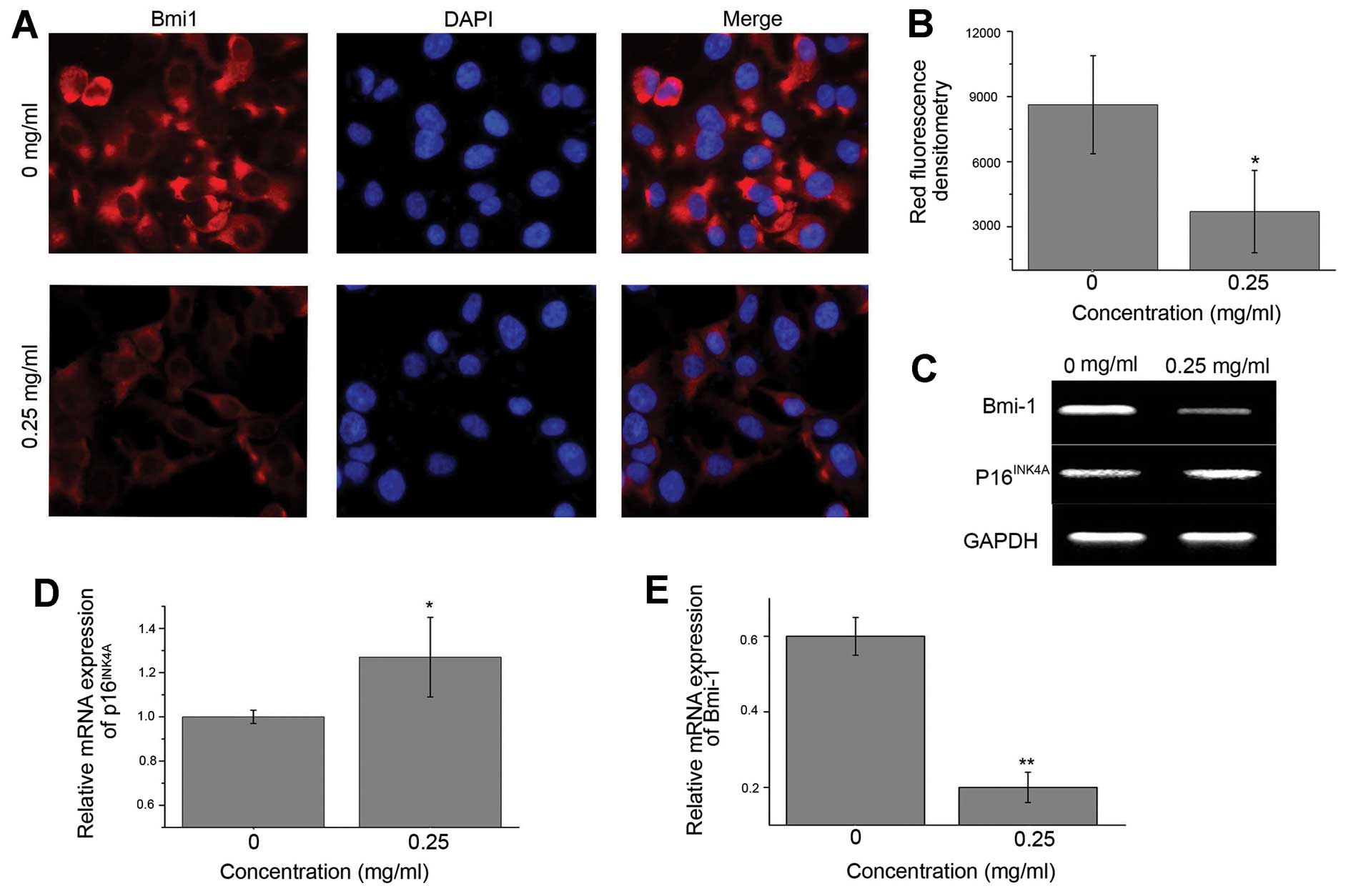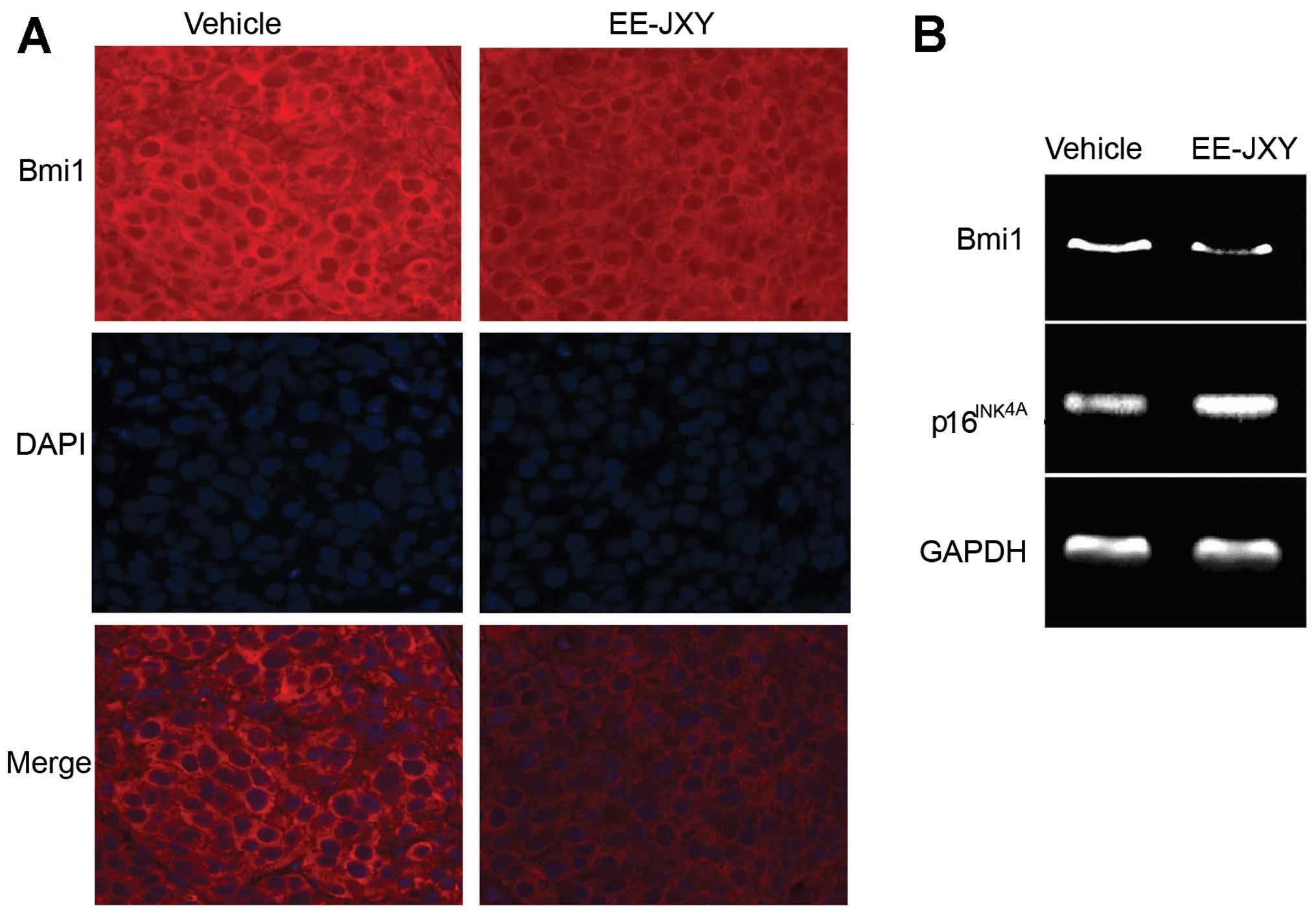Ethyl acetate extract from Jiedu Xiaozheng Yin inhibits the proliferation of human hepatocellular carcinoma cells by suppressing polycomb gene product Bmi1 and Wnt/β-catenin signaling
- Authors:
- Published online on: October 13, 2014 https://doi.org/10.3892/or.2014.3541
- Pages: 2710-2718
Abstract
Introduction
Hepatocellular carcinoma (HCC) is one of the most common malignancies in China due to the high prevalence of chronic HBV infection (1,2). According to the data published by the Chinese Society of Liver Cancer in 2009, HCC in China accounts for ~55 and 45% of the annual new cases of and deaths attributed to global HCC, respectively (3). Despite the fact that surgical resection, transplantation, local ablation (percutaneous ethanol injection, radiofrequency ablation, percutaneous acetic acid injection and microwave ablation, and transcatheter arterial chemoembolization) and immunotherapy are potentially curative modalities (4), many patients with HCC cannot be treated by these therapies due to the metastasis of cancer cells, severe adverse effects of antineoplastic drugs, or the expensive costs. Seeking alternative therapies to improve the curative rate of HCC has been an urgent task for oncologists.
Traditional Chinese medicine (TCM) herbs are widely used as complementary and alternative medicines for cancers in China (5–9). The underlying anticancer mechanisms of TCM have been extensively investigated for several decades. TCM can induce cell apoptosis and differentiation, inhibit cell division and angiogenesis, and promote immune function (reviewed in refs. 10,11). In addition, several randomized controlled trials have shown that TCM therapy can improve the quality of life of patients and alleviate chemoradiotherapy-induced adverse effects (12). TCM is considered as a valuable addition to standard cancer therapy, despite the fact that the ingredients of TCM are not completely understood.
According to the TCM theory, the combined use of several herbs may have synergic effects by acting on multiple targets. Typically, a polyherbal formula has a principal component, and others serve as adjuvant agents to enhance the pharmacological actions or facilitate the delivery of the principal component. This principle of formulation has been practiced for more than 5,000 years and is unanimously accepted by TCM physicians. For example, Realgar-Indigo naturalis formula has been verified to be effective in treating human acute promyelocytic leukemia (APL). The formula is composed of Realgar-Indigo naturalis, Salvia milliorrhizae and Radix psudostellariae. In this polyherbal formula, Realgar is a principal element and is capable of clearing heat and removing toxicity to fight APL cells. Indigo naturalis can cool the blood and detoxify the body. Salvia milliorrhizae and Radix psudostellariae have the ability to tonify Qi and invigorate blood circulation. The latter three herbs enhance the effect of Realgar in clearing heat and removing toxicity. Indeed, a pharmacological study showed that the formula has the strongest effect on fighting cancer cells compared to Realgar alone or in combination with one of the other three herbs (13).
Jiedu Xiaozheng Yin (JXY) is a polyherbal decoction to treat HCC and is composed of Hedyotis diffusa Willd (HDW), Sophora flavescens (SF), Prunella and Pseudobulbus Cremastrae (PC). In this compound decoction, HDW is the principal component intended to clear heat and toxins and resolve hard mass (including cancer). Prunella acts to clear liver fire. SF and PC can assist HDW to clear heat, detoxify the body and resolve hard mass. Pharmacological studies have shown that the four herbs are capable of inducing apoptosis and inhibiting proliferation and angiogenesis of tumor cells (14–17). A randomized control trial showed that addition of JXY to standard treatment of stage III HCC patients can improve the immune function of patients, decrease recurrence and increase overall survival (18). Experimental studies have also demonstrated that JXY can inhibit the angiogenesis of tumors via downregulation of VEGF-A and VEGFR-2 expression (19) and inhibit tumor cell proliferation via induction of G0/G1 phase arrest (9). In addition, we also found that JXY can downregulate the expression of cancer stem cell-related markers CD133 and c-kit (20). In the present study, we investigated whether the antitumor effects of JXY involve the Wnt/β-catenin pathway and the polycomb gene product, which are important regulators of cancer stem cells (21,22).
Materials and methods
EE-JXY preparation
JXY is composed of HDW (30 g), Prunella (15 g), PC (15 g) and SF (15 g). The ethyl acetate extract from JXY (EE-JXY) was prepared. Briefly, JXY (7.5 kg) was refluxed with 75% ethanol for 2 times, 3 h each time. The extract was pooled. The alcohol was removed under vacuum using a rotary evaporator. The residue was dissolved with water. The solution was partitioned sequentially with petroleum ether, chloroform, ethyl acetate and n-BuOH. The extract was evaporated in vacuum and stored at 4°C prior to use. EE-JXY was diluted using dimethyl sulfoxide (DMSO) into 200 mg/ml for the in vitro experiments. For the in vivo study, EE-JXY was dissolved in normal saline to a final concentration of 6 mg/ml.
Cell lines and culture
Human hepatocellular carcinoma PLC/PRF/5 and Huh7 cell lines were purchased from the Shanghai Institute of Life Science, Chinese Academy of Sciences (Shanghai, China), and grown in high glucose Dulbecco’s modified Eagle’s medium (DMEM) containing 10% fetal calf serum (both from Gibco, Carlsbad, CA, USA).
Cellular growth assay
The growth of cells was evaluated using the methyl thiazolyl tetrazolium (MTT) method. Briefly, adherent PLC/PRF/5 or Huh7 cells in 96-well plates were treated with EE-JXY with final concentrations of 0 (control group), 0.0625, 0.125, 0.25 and 0.5 mg/ml for 24, 48 and 72 h, respectively. Then the culture medium was discarded and MTT (Invitrogen-Life Technologies, Carlsbad, CA, USA) was added. After incubation for another 4 h, the purple-blue MTT formazan precipitate was dissolved using DMSO. The OD was measured at 570 nm. Cell growth was represented by cell viability as: Cell viability (%) = average ODJXY group/average ODcontrol group × 100%.
Flat colony formation assay
After cells were exposed to 0.25 mg/ml EE-JXY for 24 h, cells were detached by trypsin, seeded in a 6-well plate at a final concentration of 3×103 cells/ml and incubated for 10 days. Then colony formation was examined using a crystal violet cell colony staining kit (Genmed Scientifics Inc., Manassas, VA, USA) according to the manufacturer’s instructions. The colony formation ability was evaluated via the OD value at 570 nm.
Mouse xenograft model
Six-week old female BALB/c nu/nu mice were housed at 23±2°C in a humidified pathogen-free facility. Food and water were provided ad libitum. Huh7 cells at a concentration of 5×106 cells/ml were mixed with Matrigel basement membrane matrix (1:1; BD Biosciences, Franklin Lakes, NJ, USA) on ice. The 200-μl cell mixture was injected subcutaneously. When the tumor volume (TV) reached ~100 mm3, the mice were randomized into two groups and received 0.13 g/kg/day EE-JXY and normal saline, respectively by gorge. After 3 weeks, the tumors were removed for polymerase chain reaction (PCR), immunofluorescence (IF) and immunohistochemistry (IHC) assays. All procedures on treating mice were performed according to the Animal Care Guidelines issued by the Ministry of Science and Technology of P.R. China, and the Animal Care Committee of Fujian University of Traditional Chinese Medicine approved our protocol.
Reverse transcription-PCR (RT-PCR) assay
Total RNA from the tumor xenografts was extracted and subjected to reverse transcription according to the manufacturer’s recommended protocol (Invitrogen-Life Technologies and Promega, Madison, WI, USA, respectively). A 20-μl RT-PCR reaction mixture contained 10 μl of 2X Taq MasterMix (containing dNTPs, DNA polymerase, buffer, Mg2+), 400 nmol/l of each primer and 0.4 μg template DNA. Amplification conditions were as follows: 2 min at 94°C followed by 35 cycles for 30 sec at 94°C, 30 sec at 55°C and 30 sec at 72°C. The primer pairs are shown in Table I. The amplified products were size-fractionated on 1.5% agarose gel and detected by a gel imaging system (Bio-Rad, Hercules, CA, USA). The mRNA levels of samples were normalized with that of GAPDH as follows: mRNA level = (gray-scale value)sample/(gray-scale value)GAPDH.
IF analysis
The cells were seeded in a 96-well plate for 24 h. After treatment with 0 and 0.25 mg/ml EE-JXY, the cells were fixed with 4% paraformaldehyde for 10 min and incubated in blocking buffer containing Triton X-100 for 20 min. The rabbit anti-β-catenin and Bmi1 antibodies (1:250, ab32572 and ab38295; Abcam, Cambridge, MA, USA) were added and incubated at 4°C overnight. After rinsing in PBS 3 times for 10 min, the cells were incubated in the Alexa Fluor 555-labeled donkey anti-rabbit secondary antibody (1:1,000, A0453; Beyotime, Shanghai, China) for 2 h in dark. After rinsing another 3 times, 300 ng/ml 4′,6-diamidino-2-phenylindole (DAPI; C1006; Beyotime, Shanghai, China) was added to the wells. After 5 min, fluorophore was detected using a high content analysis system (BD Biosciences).
IHC analysis
The tumor xenografts were paraformaldehyde-fixed, and embedded in paraffin following standard protocols. The deparaffined tumor sections were subjected to immunostaining for proliferating cell nuclear antigen (PCNA), c-myc and cyclin D1 with appropriate antibodies (Maxin, MAB-0145, RMA-0664 and RMA-0541; Fuzhou, Fujian, China). The average percentage of positive cells was determined by counting the brown-colored cells under a microscope (Leica Microsystems, Bensheim, Germany).
Statistical analysis
Data were analyzed and processed using the SPSS 18.0 statistical software, and are presented as the mean ± standard deviation (SD) of at least three samples. Statistical comparisons between two groups were performed using the independent samples t-test, and between multiple groups were analyzed by one-way ANOVA analysis. A P-value <0.05 was considered significant.
Results
EE-JXY inhibits the proliferation of HCC cells in vitro
Our previous study demonstrated that EE-JXY inhibits the proliferation of HepG2 cells (9). To further evaluate the anticancer potential of EE-JXY for HCC, we investigated the effects of EE-JXY on the proliferation of Huh7 and PLC/PRF/5 cells by MTT assay. EE-JXY inhibited the proliferation of both HCC cell lines in dose- and time-dependent manners (Fig. 1A and B). The half maximal inhibitory concentration (IC50) was estimated to be 0.29 mg/ml for both Huh7 and PLC/PRF/5 cells at 24 h, which is similar to our previous finding for HepG2 cells (0.30 mg/ml) (9). Cells exposed to EE-JXY showed marked morphological changes: originally polygon- or spindle-shaped cells became round and collapsed, and many vacuoles appeared in the cytoplasm (Fig. 1C and D).
Colony formation assay have been used to identity cancer stem cells in vitro (23). We next evaluated the colony formation capacity of Huh7 and PLC/PRF/5 cells under the treatment of EE-JXY. Colony formation assay showed that the numbers of colonies formed by both EE-JXY-treated Huh7 and EE-JXY-treated PLC/PRF/5 cells were significantly fewer than the number in the untreated cells (Fig. 1E–H). Taken together, these data revealed that a significant growth inhibition was exerted by EE-JXY on the two HCC cell lines and possibly on the cancer stem cells.
In the following experiments, Huh7 cells were used to evaluate the anticancer mechanisms of EE-JXY.
EE-JXY regulates the Wnt/β-catenin signaling pathway
IF analysis showed that β-catenin mostly accumulated in the cytoplasm or nuclei in the untreated Huh7 cells (Figs. 2A and 3A). After treated with EE-JXY, β-catenin was mostly observed in the cytomembrane. Obviously, EE-JXY could facilitate β-catenin translocation to the cytomembrane. Interestingly, mRNA expression of β-catenin was not affected by EE-JXY. We then investigated the mRNA expression levels of β-catenin downstream genes c-myc and cyclin D1. The mRNA levels were markedly decreased in the EE-JXY-treated cells (Figs. 2B–E and 3C). IHC staining of tumor tissues from the tumor-bearing mice also showed that the percentages of c-myc-positive and cyclin D1-positive cells were decreased in the EE-JXY-treated mice compared with the control (Fig. 3B).
As PCNA is an indicator of cell proliferation and regulated by cyclin D1 (24,25), we evaluated the expression of PCNA in tumor tissues. The findings demonstrated that PCNA protein expression was inhibited in the EE-JXY-treated mice compared with the control, which is consistent with the smaller tumor volume in the EE-JXY-treated mice (Fig. 3B and D).
EE-JXY downregulates Bmi1 and upregulates p16INK4A expression
As the polycomb group (PcG) transcriptional repressor Bmi1 is a key regulator in liver cancer cell proliferation (26–29), we next examined the effect of EE-JXY on expression of Bmi1 by IF. Huh7 cells treated with EE-JXY were observed under a fluorescence microscope (Fig. 4A). Results showed that the fluorescence intensity of Bmi1 in the EE-JXY-treated cells was lower than that in the vehicle-treated cells (Fig. 4B), indicating that EE-JXY downregulated the expression of Bmi1. The result was further confirmed by RT-PCR (Fig. 4C and E).
The cyclin-dependent kinase inhibitor 2A (CDKN2A) gene product, p16INK4A, is a tumor-suppressor protein that inhibits cyclin dependent kinases 4 and 6. p16INK4A is regulated by Bmi (30). As silencing of p16INK4A is a common event in HCC (31), we investigated the expression of p16INK4A in the EE-JXY-treated cells. As expected, expression of p16INK4A was upregulated in the EE-JXY-treated cells (Fig. 4C and D). Most importantly, similar results were observed in the tumor tissues from mice treated with EE-JXY (Fig. 5).
Discussion
In the present study we demonstrated that JXY suppressed the proliferation of human hepatoma cells (PLC/PRF/5 and Huh7) at least partially by inhibiting the polycomb gene product Bmi1 and Wnt/β-catenin signaling. Due to the safety profile of JXY, JXY is a valuable adjuvant therapy for standard cancer therapy in patients with HCC.
The main members of the Wnt/β-catenin signalng pathway include Wnt (an extracellular factor rich in cysteine), frizzled (a transmembrane protein) and β-catenin (a cytoplasmic protein) (22,32–35). In the absence of Wnt, β-catenin normally locates adjacent to cell membranes. When it forms a β-catenin destruction complex with adenomatous polyposis coli (APC), axin and glycogen synthase kinase-3β (GSK-3β), β-catenin is phosphorylated and degraded. Therefore, β-catenin normally remains at a lower level in cells. In the presence of the Wnt signal, Wnt associates with frizzled, unphosphorylated β-catenin translocates from cell membranes to the cytoplasm and subsequently to the nucleus, where it activates various downstream events involved in cell apoptosis and proliferation, such as cyclin D1, c-myc and E-cadherin (34,35).
The Wnt/β-catenin signaling pathway is involved in the carcinogenesis and metastasis of a number of human cancers, such as colorectal carcinoma, breast cancer and HCC (22,31–33,36). Cui et al (37) found overexpression and abnormal accumulation in the cytoplasm or nuclei of β-catenin in HCC. Not surprisingly, pharmacological agents inhibiting the Wnt/β-catenin pathway such as sorafenib can inhibit the growth of HCC cells (38). Berberine from Coptis chinensis Franch was also reported to inhibit β-catenin/Tcf4 reporter activity and exert an antineoplastic effect (39). In the present study, cells treated with EE-JXY showed less nuclear accumulation of β-catenin, which may be responsible for reduced c-myc and cyclin D1 gene and protein expression in vitro and in vivo, and subsequent decreased expression of PCNA (40) and cell proliferation. One possible ingredient responsible for this effect is matrine in SF. Matrine was reported to regulate the Wnt/β-catenin signaling pathway in human acute erythroleukemia cell line TF-1 (41) and hepatic precancerous lesions (42).
PcG proteins are a group of transcriptional repressors regulating targeted gene expression through chromatin modifications. The PcG proteins have two core multiprotein complexes, polycomb repressive complex (PRC)-1 and -2 (43,44). Bmi1, one member of PRC-1, has been shown to function as an oncogene in multiple tumor types (43,45,46). It regulates cell proliferation, apoptosis and senescence by repressing downstream p16INK4A and p14ARF, which are suppressor genes of the INK4A/ARF locus (43,45,46). Overexpression of Bmil has been reported to be associated with the progression and aggressive biological behavior of many cancers, including HCC (47–50). Therefore Bmi1 has been a target for anticancer drug development (51). In this study, decreased expression of Bmi1 and increased expression of p16INK4A were observed in the EE-JXY-treated cells, supporting our previous finding that EE-JXY may regulate HCC cell proliferation via the cyclin D-CDK4 pathway (9).
In addition to inhibiting HCC cell proliferation and colony formation in vitro, EE-JXY markedly suppressed the expression of PCNA in vivo, an indicator of cell proliferation. As our previous study showed that EE-JXY has a strong antitumor effect in HepG2 tumor-bearing mice (9), we did not evaluate the anticancer effect of EE-JXY by comparing the tumor volumes of the EE-JXY-treated mice and the control mice, which requires a higher number of mice. To spare the animals, only 2 mice were used in each group in the present study. Notably, with the dose used in our previous study (9), stronger inhibition of PCNA expression and a smaller tumor volume were observed in the EE-JXY-treated mice.
In conclusion, EE-JXY inhibits the proliferation of PLC/PRF/5 and Huh7 cells at least in part by suppressing the Bmi1 and Wnt/β-catenin signaling pathways. Although the knowledge of the mechanism of EE-JXY action is still limited, EE-JXY may have multiple anticancer mechanisms that may deal with multiple targets in cancer cells.
Acknowledgements
The present study was supported by the National Natural Science Foundation of China (nos. 81102582 and 81302954), the Project B of Fujian Province Education Department (no. JB13101), and the Natural Science Foundation of Fujian Province (no. 2013J01335).
Abbreviations:
|
EE-JXY |
ethyl acetate extract from Jiedu Xiaozheng Yin |
|
MTT |
methyl thiazolyl tetrazolium |
|
HCC |
hepatocellular carcinoma |
|
TCM |
traditional Chinese medicine |
|
APL |
acute promyelocytic leukemia |
|
HDW |
Hedyotis diffusa Willd |
|
SF |
Sophora flavescens |
|
PC |
Pseudobulbus cremastrae |
|
DMSO |
dimethyl sulfoxide |
|
IF |
immunofluorescence |
|
IHC |
immunohistochemistry |
|
PcG |
polycomb group |
|
RT-PCR |
reverse transcription-polymerase chain reaction |
|
DAPI |
4,6-diamidino-2-phenylindole |
|
PCNA |
proliferating cell nuclear antigen |
References
|
Chen Y, Yu D, Zhang W, Qiu C, Xiang G, Dai W, Wu S and Wang X: HBV subgenotype C2 infection, A1762T/G1764A mutations may contribute to hepatocellular carcinoma with cirrhosis in Southeast China. Iran J Public Health. 41:10–18. 2012.PubMed/NCBI | |
|
Gao JD, Shao YF, Xu Y, Ming LH, Wu ZY, Liu GT, Wang XH, Gao WH, Sun YT, Feng XL, Liang LM, Zhang YH and Sun ZT: Tight association of hepatocellular carcinoma with HBV infection in North China. Hepatobiliary Pancreat Dis Int. 4:46–49. 2005.PubMed/NCBI | |
|
Ye SL: Expert consensus on standardization of the management of primary liver cancer. Zhonghua Gan Zang Bing Za Zhi. 17:403–410. 2009.(In Chinese). | |
|
Song MJ and Bae SH: Newer treatments for advanced hepatocellular carcinoma. Korean J Intern Med. 29:149–155. 2014. View Article : Google Scholar | |
|
Hu M, Zhao M, An C, Yang M, Li Q, Zhang Y, Suetsugu A, Tome Y, Yano S, Fu Y, Hoffman RM and Hu K: Real-time imaging of apoptosis induction of human breast cancer cells by the traditional Chinese medicinal herb Tubeimu. Anticancer Res. 32:2509–2514. 2012.PubMed/NCBI | |
|
Tang WM, Chan E, Kwok CY, Lee YK, Wu JH, Wan CW, Chan RY, Yu PH and Chan SW: A review of the anticancer and immunomodulatory effects of Lycium barbarum fruit. Inflammopharmacology. 20:307–314. 2012. View Article : Google Scholar : PubMed/NCBI | |
|
Park BH, Jung KH, Son MK, Seo JH, Lee HS, Lee JH and Hong SS: Antitumor activity of Pulsatilla koreana extract in anaplastic thyroid cancer via apoptosis and anti-angiogenesis. Mol Med Rep. 7:26–30. 2013. | |
|
Cao Z, Liao L, Chen X, Lan L, Hu H, Liu Z, Chen L, Huang S and Du J: Enhancement of antitumor activity of low-dose 5-fluorouracil by combination with Fuzheng-Yiliu granules in hepatoma 22 tumor-bearing mice. Integr Cancer Ther. 12:174–181. 2013. View Article : Google Scholar : PubMed/NCBI | |
|
Cao Z, Lin W, Huang Z, Chen X, Zhao J, Zheng L, Ye H, Liu Z, Liao L and Du J: Ethyl acetate extraction from a Chinese herbal formula, Jiedu Xiaozheng Yin, inhibits the proliferation of hepatocellular carcinoma cells via induction of G0/G1 phase arrest in vivo and in vitro. Int J Oncol. 42:202–210. 2013.PubMed/NCBI | |
|
Wong R, Sagar CM and Sagar SM: Integration of Chinese medicine into supportive cancer care: A modern role for an ancient tradition. Cancer Treat Rev. 27:235–246. 2001. View Article : Google Scholar : PubMed/NCBI | |
|
Qi F, Li A, Inagaki Y, Gao J, Li J, Kokudo N, Li XK and Tang W: Chinese herbal medicines as adjuvant treatment during chemo-or radio-therapy for cancer. Biosci Trends. 4:297–307. 2010.PubMed/NCBI | |
|
Li X, Yang G, Li X, Zhang Y, Yang J, Chang J, Sun X, Zhou X, Guo Y, Xu Y, Liu J and Bensoussan A: Traditional Chinese medicine in cancer care: a review of controlled clinical studies published in Chinese. PLoS One. 8:e603382013. View Article : Google Scholar : PubMed/NCBI | |
|
Wang L, Zhou GB, Liu P, Song JH, Liang Y, Yan XJ, Xu F, Wang BS, Mao JH, Shen ZX, Chen SJ and Chen Z: Dissection of mechanisms of Chinese medicinal formula Realgar-Indigo naturalis as an effective treatment for promyelocytic leukemia. Proc Natl Acad Sci USA. 105:4826–4831. 2008. View Article : Google Scholar : PubMed/NCBI | |
|
Kuo YJ, Yang JS, Lu CC, Chiang SY, Lin JG and Chung JG: Ethanol extract of Hedyotis diffusa willd upregulates G0/G1 phase arrest and induces apoptosis in human leukemia cells by modulating caspase cascade signaling and altering associated genes expression was assayed by cDNA microarray. Environ Toxicol. Mar 28–2014.(Epub ahead of print). View Article : Google Scholar | |
|
Chang C, Liu SP, Fang CH, He RS, Wang Z, Zhu YQ and Jiang SW: Effects of matrine on the proliferation of HT29 human colon cancer cells and its antitumor mechanism. Oncol Lett. 6:699–704. 2013.PubMed/NCBI | |
|
Feng L, Jia X, Zhu M, Chen Y and Shi F: Chemoprevention by Prunella vulgaris L. extract of non-small cell lung cancer via promoting apoptosis and regulating the cell cycle. Asian Pac J Cancer Prev. 11:1355–1358. 2010. | |
|
Dong H, Guo S, Wang C, Yang J and Xiao P: Advances in studies on chemical constituents in plants of Pseudobulbus Cremastrae seu Pleiones and their pharmacological activities. Zhong Cao Yao. 38:1734–1738. 2007.(In Chinese). | |
|
Chen LW, Lin J, Chen W and Zhang W: Effect of Chinese herbal medicine on patients with primary hepatic carcinoma in III stage during perioperational period: a report of 42 cases. Zhongguo Zhong Xi Yi Jie He Za Zhi. 25:832–834. 2005.(In Chinese). | |
|
Cao Z, Lin W, Huang Z, Chen X, Zhao J, Zheng L, Ye H, Liu Z, Liao L and Du J: Jiedu Xiaozheng Yin, a Chinese herbal formula, inhibits tumor angiogenesis via down-regulation of VEGF-A and VEGFR-2 expression in vivo and in vitro. Oncol Rep. 29:1083–1086. 2013.PubMed/NCBI | |
|
Cao Z, Chen X, Lin Y and Du J: Effect of Chinese compound prescription on expressions of c-kit and CD133 of tumor stem cell in mice of hepatocellular carcinoma transplanted subcutaneously. Fujian J Tradit Chin Med. 20:18–21. 2010.(In Chinese). | |
|
Chiba T, Miyagi S, Saraya A, Aoki R, Seki A, Morita Y, Yonemitsu Y, Yokosuka O, Taniguchi H, Nakauchi H and Iwama A: The polycomb gene product Bmi1 contributes to the maintenance of tumor-initiating side population cells in hepatocellular carcinoma. Cancer Res. 68:7742–7749. 2008. View Article : Google Scholar : PubMed/NCBI | |
|
Reya T and Clevers H: Wnt signalling in stem cells and cancer. Nature. 434:843–850. 2005. View Article : Google Scholar : PubMed/NCBI | |
|
Clarke MF, Dick JE, Dirks PB, Eaves CJ, Jamieson CH, Jones DL, Visvader J, Weissman IL and Wahl GM: Cancer stem cells - perspectives on current status and future directions: AACR Workshop on Cancer Stem Cells. Cancer Res. 66:9339–9344. 2006. View Article : Google Scholar | |
|
Shtutman M, Zhurinsky J, Simcha I, Albanese C, D’Amico M, Pestell R and Ben-Ze’ev A: The cyclin D1 gene is a target of the β-catenin/LEF-1 pathway. Proc Natl Acad Sci USA. 96:5522–5527. 1999. | |
|
Pagano M, Theodoras AM, Tam SW and Draetta GF: Cyclin D1-mediated inhibition of repair and replicative DNA synthesis in human fibroblasts. Genes Dev. 8:1627–1639. 1994. View Article : Google Scholar : PubMed/NCBI | |
|
Li X, Yang Z, Song W, Zhou L, Li Q, Tao K, Zhou J, Wang X, Zheng Z, You N, Dou K and Li H: Overexpression of Bmi-1 contributes to the invasion and metastasis of hepatocellular carcinoma by increasing the expression of matrix metalloproteinase (MMP)-2, MMP-9 and vascular endothelial growth factor via the PTEN/PI3K/Akt pathway. Int J Oncol. 43:793–802. 2013.PubMed/NCBI | |
|
Effendi K, Mori T, Komuta M, Masugi Y, Du W and Sakamoto M: Bmi-1 gene is upregulated in early-stage hepatocellular carcinoma and correlates with ATP-binding cassette transporter B1 expression. Cancer Sci. 101:666–672. 2010. View Article : Google Scholar : PubMed/NCBI | |
|
Wang H, Pan K, Zhang HK, Weng DS, Zhou J, Li JJ, Huang W, Song HF, Chen MS and Xia JC: Increased polycomb-group oncogene Bmi-1 expression correlates with poor prognosis in hepatocellular carcinoma. J Cancer Res Clin Oncol. 134:535–541. 2008. View Article : Google Scholar : PubMed/NCBI | |
|
Steele JC, Torr EE, Noakes KL, Kalk E, Moss PA, Reynolds GM, Hubscher SG, van Lohuizen M, Adams DH and Young LS: The polycomb group proteins, BMI-1 and EZH2, are tumour-associated antigens. Br J Cancer. 95:1202–1211. 2006. View Article : Google Scholar : PubMed/NCBI | |
|
Jacobs JJ, Kieboom K, Marino S, DePinho RA and van Lohuizen M: The oncogene and Polycomb-group gene bmi-1 regulates cell proliferation and senescence through the ink4a locus. Nature. 397:164–168. 1999. View Article : Google Scholar : PubMed/NCBI | |
|
Hui AM, Sakamoto M, Kanai Y, Ino Y, Gotoh M, Yokota J and Hirohashi S: Inactivation of p16INK4 in hepatocellular carcinoma. Hepatology. 24:575–579. 1996. View Article : Google Scholar | |
|
Micsenyi A, Tan X, Sneddon T, Luo JH, Michalopoulos GK and Monga SP: β-catenin is temporally regulated during normal liver development. Gastroenterology. 126:1134–1146. 2004. | |
|
Arend RC, Londoño-Joshi AI, Straughn JM Jr and Buchsbaum DJ: The Wnt/β-catenin pathway in ovarian cancer: a review. Gynecol Oncol. 131:772–779. 2013. | |
|
Rakheja D, Cunningham JC, Mitui M, Patel AS, Tomlinson GE and Weinberg AG: A subset of cranial fasciitis is associated with dysregulation of the Wnt/beta-catenin pathway. Mod Pathol. 21:1330–1336. 2008. View Article : Google Scholar : PubMed/NCBI | |
|
Ikeda S, Kishida S, Yamamoto H, Murai H, Koyama S and Kikuchi A: Axin, a negative regulator of the Wnt signaling pathway, forms a complex with GSK-3beta and beta-catenin and promotes GSK-3beta-dependent phosphorylation of beta-catenin. EMBO J. 17:1371–1384. 1998. View Article : Google Scholar | |
|
Pennisi E: How a growth control path takes a wrong turn to cancer. Science. 281:1438–1441. 1998. View Article : Google Scholar : PubMed/NCBI | |
|
Cui J, Zhou X, Liu Y, Tang Z and Romeih M: Wnt signaling in hepatocellular carcinoma: analysis of mutation and expression of beta-catenin, T-cell factor-4 and glycogen synthase kinase 3-beta genes. J Gastroenterol Hepatol. 18:280–287. 2003. View Article : Google Scholar : PubMed/NCBI | |
|
Wei Y, Shen N, Wang Z, Yang G, Yi B, Yang N, Qiu Y and Lu J: Sorafenib sensitizes hepatocellular carcinoma cell to cisplatin via suppression of Wnt/β-catenin signaling. Mol Cell Biochem. 381:139–144. 2013.PubMed/NCBI | |
|
He B, Kang Q, Yang J, Shang J, He T and Zhou Q: Correlation between antitumor activity of berberine and the inhibition of Wnt/beta-catenin signal pathway. Zhongguo Yaolixue Tongbao. 21:1108–1111. 2005.(In Chinese). | |
|
Kumar DU and Devaraj H: Expression of Wnt 3a, β-catenin, cyclin D1 and PCNA in mouse dentate gyrus subgranular zone (SGZ): a possible role of Wnt pathway in SGZ neural stem cell proliferation. Folia Biol (Praha). 58:115–120. 2012. | |
|
Zhou CJ, Shi LJ, Fu LH, Wang L, Yu YC, Hu CL and Chen L: Effect of matrine on expressions of SALL4 gene and downstream target genes of Wnt/β-catenin signaling pathway in human acute erythroleukemia cell line TF-1. Chin J Biol. 26:94–98. 2013. | |
|
Gao JT: Modulating action of matrine on rat hepatic precancerous lesion and Wnt signaling transduction pathway. http://d.g.wanfangdata.com.cn/Thesis_Y1354799.aspx. Shijiazhuang: Heibei Medical University; 2008, (In Chinese). | |
|
Sparmann A and van Lohuizen M: Polycomb silencers control cell fate, development and cancer. Nat Rev Cancer. 6:846–856. 2006. View Article : Google Scholar : PubMed/NCBI | |
|
Valk-Lingbeek ME, Bruggeman SW and van Lohuizen M: Stem cells and cancer; the polycomb connection. Cell. 118:409–418. 2004. View Article : Google Scholar : PubMed/NCBI | |
|
Park IK, Morrison SJ and Clarke MF: Bmi1, stem cells, and senescence regulation. J Clin Invest. 113:175–179. 2004. View Article : Google Scholar : PubMed/NCBI | |
|
Fan L, Xu C, Wang C, Tao J, Ho C, Jiang L, Gui B, Huang S, Evert M, Calvisi DF and Chen X: Bmi1 is required for hepatic progenitor cell expansion and liver tumor development. PLoS One. 7:e464722012. View Article : Google Scholar : PubMed/NCBI | |
|
Sawa M, Yamamoto K, Yokozawa T, Kiyoi H, Hishida A, Kajiguchi T, Seto M, Kohno A, Kitamura K, Itoh Y, Asou N, Hamajima N, Emi N and Naoe T: BMI1 is highly expressed in M0-subtype acute myeloid leukemia. Int J Hematol. 82:42–47. 2005. View Article : Google Scholar : PubMed/NCBI | |
|
Silva J, García V, García JM, Peña C, Domínguez G, Díaz R, Lorenzo Y, Hurtado A, Sánchez A and Bonilla F: Circulating Bmi-1 mRNA as a possible prognostic factor for advanced breast cancer patients. Breast Cancer Res. 9:R552007. View Article : Google Scholar : PubMed/NCBI | |
|
Liu JH, Song LB, Zhang X, Guo BH, Feng Y, Li XX, Liao WT, Zeng MS and Huang KH: Bmi1 expression predicts prognosis for patients with gastric carcinoma. J Surg Oncol. 97:267–272. 2008. View Article : Google Scholar : PubMed/NCBI | |
|
Sasaki M, Ikeda H, Itatsu K, Yamaguchi J, Sawada S, Minato H, Ohta T and Nakanuma Y: The overexpression of polycomb group proteins Bmi1 and EZH2 is associated with the progression and aggressive biological behavior of hepatocellular carcinoma. Lab Invest. 88:873–882. 2008. View Article : Google Scholar : PubMed/NCBI | |
|
Cao L, Bombard J, Cintron K, Sheedy J, Weetall ML and Davis TW: BMI1 as a novel target for drug discovery in cancer. J Cell Biochem. 112:2729–2741. 2011. View Article : Google Scholar : PubMed/NCBI |



